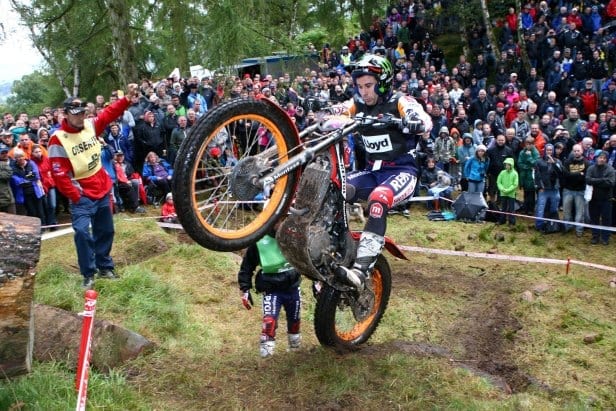Bou’s show-stopper
By TMX Archives on 4th Jan 13

When Toni Bou took a magnificent double win in the British Round of the 2012 World Trials Championship back on the weekend July 28/29 and Britains James Dabill claimed his first ever WTC podium on the final day, no-one knew that this would be the last ever World Round run under Stop Permitted rules and that No-Stop observing would make a surprise return, some 30 years after being ousted following a revolution in trials riding.
Ever since the inception of trials, back in the early days of the 20th century, the whole essence of the sport was to ride a given obstacle, section or observed hill without stopping or resorting to legwork – or footing as it was known.
You've all seen those cracking old grainy black and white pics of gentlemen riders, often wearing collars and ties and flat caps set at jaunty angles, sometimes worn backwards, with goggles fixedready for a stretch of road work.
These intrepid chaps invariably wore long coats that enveloped their legs and which became known as footing or dabbing coats, as legend had it that you could get away with dabs as the observer couldn't see whether your foot had left the pegs due to the acres of flapping material.
The observing rules, in my living memory at least, were one mark for a dab, three marks for more than one dab and a great big "no questions asked” FIVE for the machine failing to maintain forward motion – otherwise known as a Stop.
The rules were later modified slightly to include a two-mark penalty to differentiate between a competitor who only dabbed twice and one who legged or paddled through a section.
And this is how it happily remained until the late 1970s, early 1980s when a new breed of rider, headed by American teenager Bernie Schreiber, began to turn trials on its head.
Bultaco-mounted Bernie kicked it all off with his trademark ‘pivot turn' in which he lofted the front wheel up and over
obstacles, that defied riding in traditional style.
This evolved momentary stopping in which the front wheel was hopped sideways in sections, before further evolving into riders stopping and manoeuvring their front wheels before tackling big steps.
World Championship clerks of the course responded with tighter turns and bigger steps and observers responded by allowing these antics, because they were simply under pressure to do so. Riders such as Gilles Burgat and Eddy Lejeune prospered under the new format, as teenagers like John Lampkin and Steve Saunders came through to replace the old guard of No Stop aces such as Martin Lampkin, Malcolm Rathmell, Ulf Karlsson, Yrjo Vesterinen and co.
And trials bike design altered equally radically, with ever-lighter models sporting steeper steering angles, more suspension travel and more zippy, responsive engines replacing the older heavy flywheel plodders.
FOR FULL REPORT AND PICTURES SEE TMX NEWS, JANUARY 4


